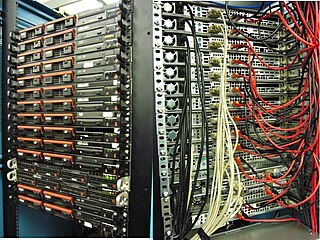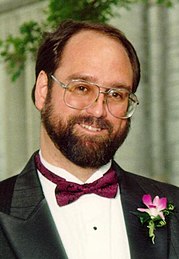
A bulletin board system (BBS), also called a computer bulletin board service (CBBS), is a computer server running software that allows users to connect to the system using a terminal program. Once logged in, the user can perform functions such as uploading and downloading software and data, reading news and bulletins, and exchanging messages with other users through public message boards and sometimes via direct chatting. In the early 1980s, message networks such as FidoNet were developed to provide services such as NetMail, which is similar to internet-based email.
FidoNet is a worldwide computer network that is used for communication between bulletin board systems (BBSes). It uses a store-and-forward system to exchange private (email) and public (forum) messages between the BBSes in the network, as well as other files and protocols in some cases.

Lycos, Inc., is a web search engine and web portal established in 1994, spun out of Carnegie Mellon University. Lycos also encompasses a network of email, web hosting, social networking, and entertainment websites. The company is based in Waltham, Massachusetts, and is a subsidiary of Ybrant Digital.
UUCP is a suite of computer programs and protocols allowing remote execution of commands and transfer of files, email and netnews between computers.

CBBS was a computer program created by Ward Christensen and Randy Suess to allow them and other computer hobbyists to exchange information between each other.
An online service provider (OSP) can, for example, be an Internet service provider, an email provider, a news provider (press), an entertainment provider, a search engine, an e-commerce site, an online banking site, a health site, an official government site, social media, a wiki, or a Usenet newsgroup.

Diversi-Dial, or DDial was an online chat server that was popular during the mid-1980s. It was a specialized type of bulletin board system that allowed all callers to send lines of text to each other in real-time, often operating at 300 baud. In some ways, it was a sociological forerunner to IRC, and was a cheap, local alternative to CompuServe chat, which was expensive and billed by the minute. At its peak, at least 35 major DDial systems existed across the United States, many of them in large cities. During the evening when telephone rates were low, the biggest DDial systems would link together using Telenet or PC Pursuit connections, forming regional chat networks.
The Bread Board System (TBBS) is a multiline MS-DOS based commercial bulletin board system software package written in 1983 by Philip L. Becker. He originally created the software as the result of a poker game with friends that were praising the BBS software created by Ward Christensen. Becker said he could do better and founded eSoft, Inc. in 1984 based on the strength of TBBS sales.
WWIV was a popular brand of bulletin board system software from the late 1980s through the mid-1990s. The modifiable source code allowed a sysop to customize the main BBS program for their particular needs and aesthetics. WWIV also allowed tens of thousands of BBSes to link together, forming a worldwide proprietary computer network, the WWIVnet, similar to FidoNet.

The Major BBS was bulletin board software developed between 1986 and 1999 by Galacticomm. In 1995 it was renamed Worldgroup Server and bundled with a user client interface program named Worldgroup Manager for Microsoft Windows. Originally DOS-based, two of the versions were also available as a Unix-based edition, and the last versions were also available for Windows NT-based servers.

FirstClass is a client–server groupware, email, online conferencing, voice and fax services, and bulletin-board system for Windows, macOS, and Linux. FirstClass's primary markets are the higher-education and K-12 education sectors, including four of the top ten largest school districts in the United States.
C-Net DS2 was a full featured, single-line, bulletin board system (BBS) software system released in 1986 for the Commodore 64 microcomputer. The DS2 system was notable in that its authors proved that it was possible to perform significant and useful serious computing tasks on a hardware platform with such severely limited resources that even the manufacturer called it only a "game machine".
Canada Remote Systems, or simply CRS, was a major commercial bulletin board system located in the Toronto area. It was one of the earliest commercial systems outside the "big iron" companies such as CompuServe or The Source, and survived into the 1990s before being overwhelmed by the Internet and closing down.
Mustang Software, Inc. was a California-based corporation that developed telecommunications software products. Mustang was incorporated in 1988, became a public corporation in 1995, and was finally merged into Quintus Corporation in 2000.

TOTSE (,) was a San Francisco Bay Area website and former BBS dedicated to storing text files on a variety of subjects and viewpoints, many of which were unusual or controversial. The name is an acronym for Temple of the Screaming Electron.
There are several notable bulletin board systems (BBS) for the TI-99/4A home computer.
GT Power is a bulletin board system (BBS) and dial-up telecommunications/terminal application for MS-DOS. It was first introduced in the 1980s by P & M Software, founded by Paul Meiners. GT Power can be used both to host a BBS as well as to connect to other BBS systems via its full-featured dial-up "terminal mode". GT Power was a shareware package that required a registration fee in order to access its proprietary network mail transport/handling software and, by default, the GT Power Network. The software is distributed in two "flavors": a terminal-only version, nicknamed GTO, and the full-featured host and terminal version.
StarDoc 134 is a Dos/Linux hybrid BBS running EleBBS maintained by Andrew Baker aka "RamMan, Dotel and Dotelpenguin".

A modulator-demodulator or modem is a computer hardware device that converts data from a digital format into a format suitable for an analog transmission medium such as telephone or radio. A modem transmits data by modulating one or more carrier wave signals to encode digital information, while the receiver demodulates the signal to recreate the original digital information. The goal is to produce a signal that can be transmitted easily and decoded reliably. Modems can be used with almost any means of transmitting analog signals, from light-emitting diodes to radio.

Super Dimension Fortress is a non-profit public access UNIX shell provider on the Internet. It has been in continual operation since 1987 as a non-profit social club. The name is derived from the Japanese anime series Super Dimension Fortress Macross; the original SDF server was a Bulletin board system created by Ted Uhlemann for fellow Japanese anime fans. From its BBS roots, which have been well documented as part of the BBS: The Documentary project, SDF has grown into a feature-rich provider serving members around the world.











